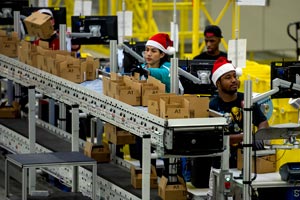Retail Sales Growth Expected to Slow This Holiday Season

U.S. retail sales this holiday season will grow at a slower pace than last year, with consumers spending more of their disposable income on services than gifts, the National Retail Federation said.
Consumer purchases may advance 3.7% to $630.5 billion in November and December, the Washington-based NRF said in a statement Oct. 8. The sales climbed 4.1% in 2014, though the current year’s growth is still better than typical for the past decade. The 10-year average has been 2.5%, the trade group said.
“Consumers have shifted some of their demand toward services and away from goods,” NRF Chief Economist Jack Kleinhenz said in an interview. “Consumers are buying things — there’s no doubt about it. They’re spending money on autos, on big-ticket items, and we’ve seen a big pickup in restaurants and personal services.”
Families are devoting more of their budgets to things like travel and tax preparation, taking away from boxes under the tree, Kleinhenz said. Slow growth in hourly wages in 2015 also may be hampering spending. To lure reluctant consumers, retailers will have to compete for the lowest prices, the most convenient store hours and the best digital features.
E-commerce sales growth will continue to outpace the brick-and-mortar world, the group said. Holiday sales outside of stores may rise as much as 8% to $105 billion in November and December, the NRF estimates. That would be greater than the 5.8% sales growth last year, excluding automobiles, gasoline, restaurants and travel.
Consumers have plenty to be nervous about during this season, which accounts for about 19% of the retail industry’s annual sales. Financial-market volatility and slowing growth globally may outweigh benefits from higher employment rates, better home values and lower gas prices. Still, consumers are making large purchases. Cars and light trucks are selling at their fastest pace in a more than a decade.
The NRF’s holiday estimate was lower than a projection from Deloitte, which said last month that sales in stores may increase as much as 4%. AlixPartners, meanwhile, predicted that the growth could range from 2.8% to 3.4%.
Retailers seem to be taking note of the lower expectations: Seasonal staffing levels for the biggest chains are going to be flat or slightly below last year’s levels. Wal-Mart Stores Inc. and Target Corp. announced plans to hire about the same number of temporary employees as in 2014, and Macy’s Inc. and Toys “R” Us Inc. will hire fewer seasonal workers.
The shift to online purchases has put more weight on major shipping companies. UPS Inc. plans to keep hiring steady, adding as many as 95,000 employees from November to January. FedEx Corp. will boost its seasonal workforce by 5,000 this year to 55,000.
Although the forecast calls for slower growth than last year, retailers still have the opportunity to win over consumers, Kleinhenz said.
“I remain optimistic about the economy,” he said. “The strength in the consumer is there.”


